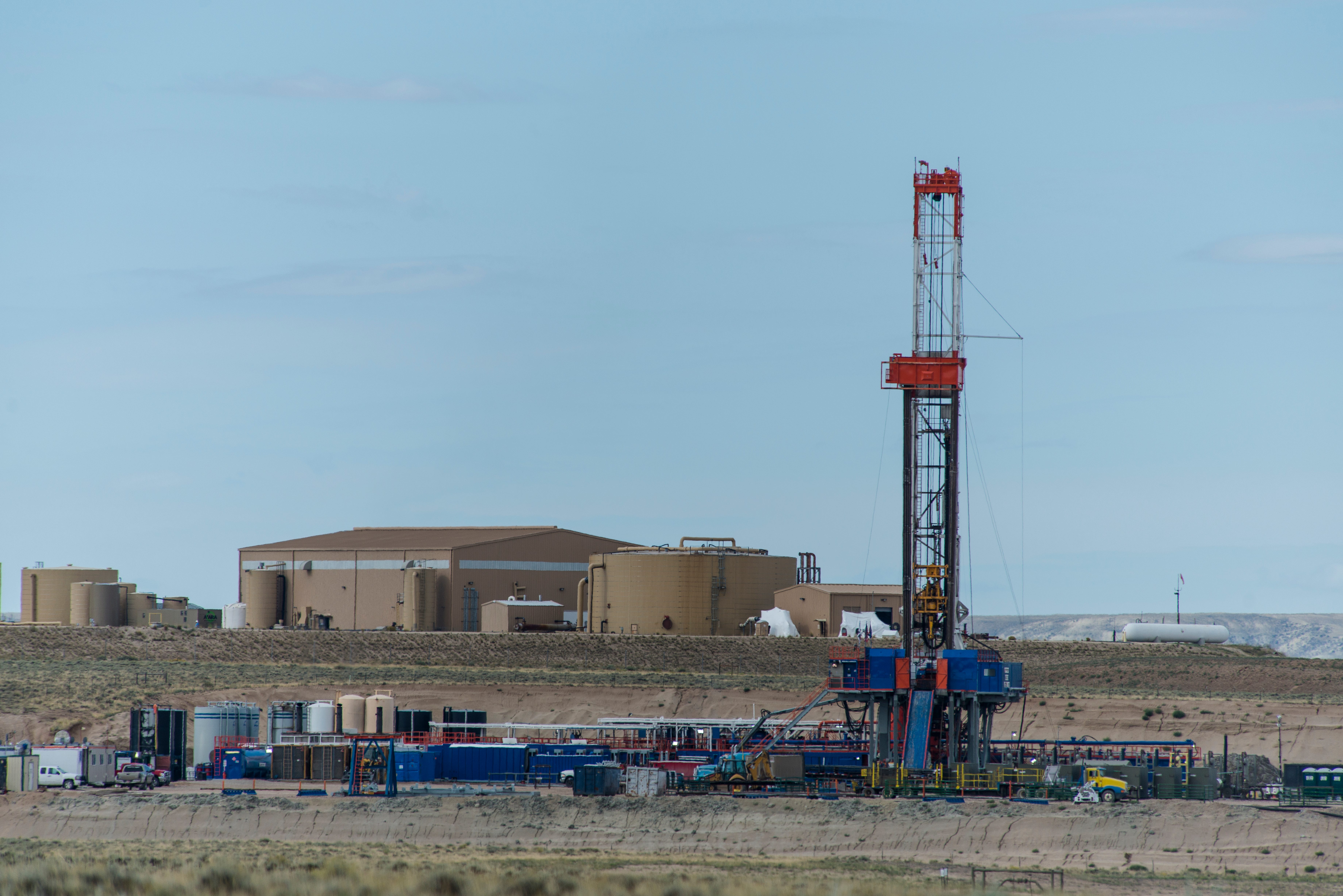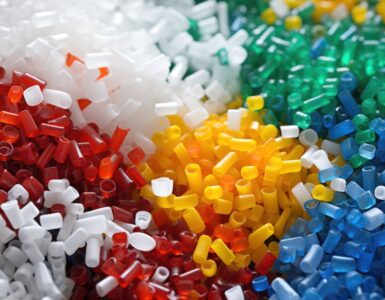Facing Severe Droughts, Ranchers Are Resorting to Using Fracking Water to Save Their Land
Using a patent-pending cleaning process, a Wyoming company hopes to water ranchlands with the notoriously nasty byproduct from oil and gas wells

When people think about fracking, most think about fossil fuels. But Wyoming rancher Owen Goertz, 70, thinks about water. Specifically, the approximately 5,000 to 8,000 barrels a day of fracking byproduct water that is currently produced on his land. For the last 30 years, Goertz has leased out oil and gas rights on his 10,000-acre ranch. Those wells have pumped countless barrels of oil, as well as all that water, which is piped away by the oil company and disposed of, unused, while he grapples with relentless drought conditions that make it difficult to feed his cows and keep his family ranch afloat.
Not anymore. This spring, for the first time, Goertz plans to reclaim, clean up, and reuse that water to irrigate his ranchlands.
He and his partners hope this project will not only return much-needed water to his land, but give cattle ranchers in the arid west a better chance of surviving climate change. In addition to finding an environmentally positive use for this otherwise wasted water, reclaiming fracking fluid has the potential to reshape the expensive disposal process that the oil and gas industry relies on now.
Wyoming is the fifth-driest state in the nation and is currently experiencing severe to extreme drought levels. The situation is expected to worsen as the climate crisis continues. Goertz is working with the startup Encore Green Environmental, a company that claims to be the first to hold permits to reclaim water from fracked wells for agricultural irrigation.
While Goertz sees a lot of potential for progress, it must be noted that the oil and gas industry is of course a major contributor to climate change. As environmental groups opposed to such projects point out, the climate crisis is the reason drought-stricken ranchers like Goertz are desperate for more water in the first place.
Still, the short-term gains are alluring. Goertz has received permits and is negotiating with Kaiser-Francis Oil Company, the company operating the wells on his land, for the rights to the byproduct water those wells generate. He plans to use that water to irrigate a portion of his pasture lands to produce more feed for his cattle.
Marvin Nash, co-founder of Encore Green Environmental, is a former rodeo clown with a lifetime of experience working with farmers and ranchers. He says if he can make sure fracking byproduct water, known as “produced” wastewater, is clean and safe, it could mean the difference for a rancher like Goertz surviving a drought and passing his ranch onto his grandchildren.
“Drought hurts. But what do you do? You buy hay or you sell cows. There’s only two options,” Nash says. The ability for Goertz to irrigate even a few hundred acres of his total 10,000 would mean he could harvest enough extra hay for his 300-head herd of Angus cows to get through a drought period.
Drought has become a way of life in the arid U.S. western states, and it’s predicted to only get worse. In April 2024, scientists from Columbia University released a study indicating that a climate change-fueled “megadrought” — worse than anything known in history — is now underway in the western United States and northern Mexico.
U.S. domestic oil and gas production creates up to 2.4 billion gallons of produced wastewater a day. Traditionally, this water has been disposed of rather than reused for fear of potential water and soil contamination. Most oil and gas companies either inject the byproduct water into shallow disposal wells or hold it in containment evaporation ponds. Managing it is a significant expense, costing anywhere from 1 cent to $5 per barrel. Approximately 21 billion barrels (one barrel is 42 U.S. gallons) of produced water are generated a year in the United States.
Nash co-founded Encore Green with his wife Darlene in 2017 because they couldn’t stand seeing all that water put to no good use.
“Coming from South Texas, the Rio Grande valley, I understood drought,” Nash says. “It just boggles my mind. How can we waste this water?”
In late October 2024, after several years of work with Wyoming’s environmental and agricultural regulators and the state oil and gas commission, Encore Green successfully received permits to irrigate a ranch on the Nebraska-Wyoming border with 7,000 barrels of produced water.
Encore Green hopes to convince the oil and gas industry that it is cheaper and better for the environment to pay a company like them to clean up and reuse fracking byproduct water than to pay for the disposal costs themselves. Encore cleans the water with technology appropriate to each batch. That may include reverse osmosis, mechanical vapor compression (MVC), or a combination of both. This intensely compressed heating process essentially creates “distilled water,” says Darren Smith, Encore’s Director of ESG and Technologies.
Traditionally MVC is considered an energy intensive (and expensive) process, but Encore negotiates the rights to use another oil and gas environmental black eye — flare gas — — as their energy source. Flare gas is the mostly unregulated burning of unsellable waste gas, mostly methane, produced at operating oil wells. Flaring is thought to contribute 1% of man-made atmospheric carbon dioxide emissions globally, and the United States holds the dubious distinction of being one of the world’s top five flaring nations. But since Encore’s MVC setup is located at the wellhead where both byproduct water and flare gas is produced, it made perfect sense to make use of that excess gas as an energy source, Nash says.
The company aims to capitalize on the environmental benefits that irrigation can kickstart. Encore recently launched a nonprofit arm to help ranchers use that water in conjunction with good land management practices to increase soil health, making it more productive and drought-resistant over the long term. A rancher like Goertz could make even better use of that water if he could afford to also buy seed and equipment to replant his degraded pastures into a more diverse mix of healthy plants.
Ultimately, Nash says, using reclaimed fracking byproduct water alongside good land management practices could result in carbon sequestered in the ground and better soil health — a win for the oil and gas industry and ranchers.
“If we can increase the water, we can increase the soil health,” says Nash. “If we can increase the soil health, what do we get? Bingo, we capture more carbon out of the air.”
But putting fracking byproduct water on agricultural lands is not safe, warns Food and Water Watch, an advocacy group that opposes fracking. This water, which comes up naturally with the production of oil and gas, is usually extremely salty — far above sea water levels — and can contain potentially dangerous contaminants, including benzene (a human carcinogen) and naturally occurring radioactive substances. And again, the burning of fossil fuels obtained through fracking is a large contributor to the increased atmospheric carbon dioxide that causes climate change — and with it, the severe droughts ranchers like Goertz are experiencing.
Reclaiming fracked byproduct water “is a practice that greenwashes the industry,” Amanda Starbuck, senior food researcher and policy analyst at Food and Water Watch, tells Future Human. “It allows them to have a website with pretty flowers and landscapes and saying they are doing the right thing. When in fact they are part of the problem with climate change.”
She isn’t convinced that anything good that comes from using fracking byproduct wastewater for irrigation is enough to compensate for the environmental damage caused by the fracking process and burning of fossil fuels themselves.
“Finding a way to reuse this water is not going to make this better,” Starbuck says.
Just starting a new fracking operation already uses significant water resources. Wells are created by drilling down at least one to two miles from the surface, then drilling horizontally once the natural layer of oil or gas is reached. Then, a combination of water and chemicals is pumped into the well at high pressure, creating cracks through which oil and gas flow. The initial liquid pumped in comes back up as the well produces oil and is called “flowback water.” Eventually, it clears, and a steady supply of byproduct water from natural underground sources comes up with every barrel of oil produced as long as the well is active. According to Food and Water Watch, it takes an average of about 5 million gallons of water to drill and frack a single well, although some regions use significantly more. Some wells in Texas have been fracked using more than 13 million gallons of water per well.
Fracking byproduct water does not have to meet the conditions of the Clean Water Act, thanks to a loophole passed during the George W. Bush administration. This loophole prohibits the Environmental Protection Agency from requiring oil and gas companies to meet Safe Drinking Water standards before disposing of byproduct water. It has led to polluted community drinking water and has even been linked to the death of livestock and pets.
Despite all the concerns about reusing byproduct water, Encore is not the only entity attempting to do it. Under the Trump administration, the EPA took a new look at the management of byproduct water and found that, while large volumes of wastewater generated by the oil and gas industry are expected to increase, underground injection disposal as a mitigation strategy is limited. It did not “make sense to continue to waste this water, particularly in water-scarce areas of the country,” the EPA noted in its report. The EPA made no recommendations, but noted the oil and gas industry’s push for more disposal options as well as concerns from NGOs and academics about water toxicity, a lack of data, and the expense of cleaning up fracking wastewater.
For decades, California has allowed farmers to irrigate with minimally treated produced water from San Joaquin valley fracking wells (which naturally have less saline than water from Wyoming). The theory is that diluting the byproduct water with clean water makes it safe for agricultural irrigation use. Food and Water Watch begs to differ.
“Farmers who are getting the water through the canals have no control over what that water is, they don’t even know what is in the water,” Starbuck says.
Nash agrees that “dilution is not the solution.” That’s why at Encore, they use a batch process to purify water: Every batch is pretested, cleaned, and then tested again before it’s applied — and it isn’t applied if they can’t get it clean.
Groups like Food and Water Watch have a misperception, Nash argues, that Encore is testing and cleaning a single beaker of water, and once they get approval, “turning on the spigot.”
Encore depends on local environmental regulators to be told what to test the water for. While oil and gas companies don’t make their lists of chemicals public, they are required to release that information to the agency that approved their well permit. In Wyoming, that’s the Wyoming Oil and Gas Conservation Commission. When Encore applies for permission to reuse the byproduct water from that well, the Wyoming Department of Environmental Quality issues them a permit telling them the accepted levels for different chemicals, or “what must not be in the water,” says Jeff Holder, Encore’s general manager.
Encore’s first permit had a list of 500 chemicals, including DDT, a chemical that has been banned since 1972, Nash says. The bottom line, he says, is that any chemical a group like Food and Water Watch is concerned about, Encore is happy to test for.
Nash knows that ranchers, environmental groups, and the oil and gas industry make up “strange bedfellows.” That hasn’t dimmed his optimism that they can find ways to work together, especially as long as fracking is approved and wells are operating in drought-stricken states on rancher’s lands. Encore has three more permits to apply cleaned-up fracking wastewater on ranches in Wyoming and is currently working on permits in Texas and Utah.
“You don’t get a lot of environmentalists showing up and saying here, let me help you make more oil so we can water more land, so we can have more clean air,” he says.
Fracking itself doesn’t appear to be going anywhere in the near future. The Biden administration paused issuing new leases for fracking wells on public lands — a far cry from Biden’s campaign promise to ban new fracking on federally owned lands.
Encore is a present-day solution as the U.S works toward carbon neutrality, Holder says. “We can’t turn off the oil spigots today. We need something for today and something for tomorrow.”
Nash agrees.
“Did you hear the one about the cowboy that went to the psychologist?” he asks. “The doctor filled up a whiskey glass half full and asked, is that shot glass half full or half empty? The cowboy picked it up, drank it, and said, ‘I don’t care, I’m just here to solve problems’.”



























